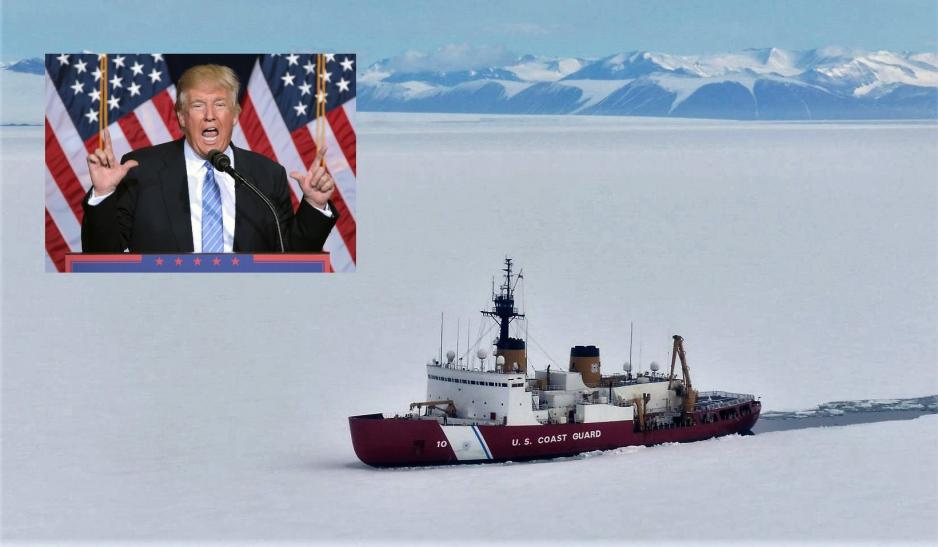U.S. to Speed Up Its Icebreaker Program, May Develop Nuclear Arctic Vessels

US President Donald Trump wants to replace U.S. Coast Guard Cutter Polar Star. (Source: U.S. Coast Guard/ Chief Petty Officer Nick Ameen)
The U.S. government aims to accelerate its Arctic icebreaker program and is evaluating the need for armed vessels and the feasibility of constructing nuclear icebreakers.
The United States continues its recent string of military exercises, briefings, and speeches related to the Arctic. Earlier this week President Trump released a “Memorandum on Safeguarding U.S. National Interests in the Arctic and Antarctic Regions.”
The new document calls for an accelerated timeline for the establishment of a fleet of polar security icebreakers by 2029. It also asks government departments to explore the feasibility of procuring nuclear-powered icebreakers and to evaluate what level of armament will be required on the vessels for defensive purposes.
Construction of the first new U.S. Coast Guard icebreaker began earlier this year, but it will not enter into service until 2025 at the earliest. In order to bridge the anticipated icebreaker gap – the U.S.’ only heavy icebreaker Polar Star is 44 years old and quickly approaching the end of its useful service life – Trump wants to explore the possibility of leasing icebreakers, either domestically or internationally. He also calls for the procurement of a whole fleet of icebreakers, including at least three heavy and three medium icebreakers.
The memorandum also requests U.S. government departments, including the Departments of Defense, Homeland Security, and Energy, to identify at a minimum two domestic and two international locations where vessels of the future icebreaker fleet will be based. Trumps asks that the results of these evaluations will be delivered to the White House within 60 days.
Some Arctic experts have long advocated for the U.S. to take a more active role in the region, and part of that commitment is the capability of operating in the Arctic.
“It is about time the U.S. takes its commitment to Arctic maritime security and naval capabilities seriously,” confirms Andreas Østhagen, Senior Research Fellow at Norway’s Fridtjof Nansen Institute (FNI) and researcher at the High North Center for Business and Governance.
Limited options to speed up new icebreaker
The U.S. has continually stepped up its Arctic engagement in recent years. After the first visit of a Navy aircraft carrier to the region in almost 30 years as part of the NATO exercise Trident Juncture in 2018, the U.S. Navy followed up with an exercise off of Iceland in 2019 and in the Barents Sea last month.
It also expanded its Arctic policy aiming to “become the partner of choice” in the region. As part of that effort it provided $12.1 million in development aid to Greenland and announced the reopening of the U.S. consulate in Nuuk. The consulate became operational June 10.
It is about time the U.S. takes its commitment to Arctic maritime security and naval capabilities seriously.
Despite these efforts, according to U.S. Coast Guard leadership the service remains underprepared for its expanded role in the region, especially in terms of icebreaker capacity. It operates a 44 year-old heavy icebreaker (Polar Star) and a 21 year-old medium icebreaker (Healy). It took the Coast Guard more than a decade to secure the necessary funding from the U.S. Congress to move forward with the procurement of new icebreakers.
Likewise, the president’s memorandum leaves open the issue of how to pay for an accelerated procurement of new icebreakers or where funding for the leasing of icebreakers or even the development of a nuclear icebreaker program would come from.
Wanted: Icebreaker for lease
Especially noteworthy is the suggestion to lease icebreakers domestically or abroad. However, this proposal goes counter to the fact that there are only a handful of icebreakers in the United States that are not operated by the Coast Guard. None of these vessels are suitable for the task of maintaining or expanding the Coast Guard’s presence in the region.
Internationally, the U.S. could possibly lease icebreakers from private or state-owned operators, such as Finnish Arctia. But again, the majority of icebreakers, especially those capable of operating in difficult ice conditions in the Arctic, are routinely leased out for scientific expeditions or Antarctic resupply-missions.
Also, operating a ship that was not constructed in the U.S. may also run afoul of the Jones Act, which forbids foreign-built ships to operate between U.S. ports – a measure meant to support domestic shipbuilding.
Questions arise over armed icebreakers
Trump’s proposal to explore the need to “adequately arm” future Coast Guard icebreakers comes just weeks after U.S. military officials criticized Russia for arming one of its latest icebreakers.
“Who puts missiles on icebreakers,” asked Admiral James G. Foggo III, Commander of the U.S. Naval Forces Europe and Africa.
Now, security and Arctic experts ask the same question of the U.S.
“If we want the Arctic to be a zone of peace, we shouldn’t build armed icebreakers. Icebreakers are an important part of providing access to the polar regions - including for armed vessels. But they probably shouldn’t be armed themselves,” explains Andrew Holland, Chief Operating Officer of the American Security Project, a Washington DC-based think tank.
Similarly, the suggestion to develop a nuclear icebreaker program raised eyebrows in the Arctic community. Russian nuclear icebreakers serve a very specific purpose, namely escorting commercial ships along the Northern Sea Route. These types of powerful icebreakers would be of little use to the U.S. Coast Guard and would be prohibitively expensive to develop and maintain, experts suggest.
What do more U.S. icebreakers mean for allies?
In recent years U.S. allies have grown increasingly weary of the country’s rhetoric calling out and criticizing Russia’s and China’s activities in the Arctic on numerous occasions. So how does a fleet of American icebreakers affect other Arctic states, including Norway?
“From a Norwegian perspective, there is little [in the memorandum] that directly influences us. It is unlikely that the polar security cutters will play a big role in the North-East Atlantic or Barents Sea,” explains Østhagen.
The vessels’ presence will be more relevant for cooperation with Canada and Greenland. Another purpose could be sovereignty enforcement and security tasks, especially in the Bering Strait and Chukchi Sea region given the steady increase in Arctic shipping traffic.



